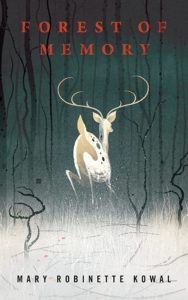Forest of Memory, a novella from 2016, finds Mary Robinette Kowal writing in a very different mode from her two well-known series, the Glamourist Histories and the Lady Astronaut books. Two hundred or so years into the future, material abundance and pervasive interconnection have left some very wealthy people hungering for the real, for the unique. Katya Gould, Kowal’s first-person narrator, deals in Authenticities — objects with provenances traceable to a past that readers will recognize but that seems lost to the story’s world — and in Captures — unusual moments recorded and sold onward. The tale is Katya’s account, for a client about which she knows very little.
As you’ve requested, to guarantee this is a unique document, I’m typing it on the 1918 Corona 3 typewriter that I had in my bicycle cart when I was abducted by the man known as Johnny. You will receive both these pages and the typewriter.
And all of the typos that accompany this account. (p. 11)
Katya’s account relates a visit to a winery, a normal encounter in her line of work, and her plans to bicycle through a section of forest to catch a train to her home in a different part of Oregon. Readers get a glimpse of the relative positions of humans and wildlife when Katya gets a warning from the net that deer are expected to cross her path, and that she should keep sufficient distance to leave them undisturbed or face a fine large enough to give her pause. She decides to wait, and in due course the deer cross the road in front of her. She’s recording the event — it might turn out to be a valuable Capture — little realizing that she has already lost connection to the net and is filling the last bits of her onboard cache.
That will turn out to be crucial when a gunshot rings out, “as if a firecracker had gone off next to my ear. One of the deer jerked and fell. The crack came again, and another fell, and —” (p. 25) Katya finds herself in a dark wood, and the straightforward path has been lost. The rest of the story is part meditation on memory, part tense tale of kidnapping, and part mythical exploration of people, nature, and technology.
If bicycling too close to wild deer is grounds for a hefty fine, how much worse is shooting them? Even if, as Katya soon learns, the man with the gun is just tranquilizing them. Why is he taking that risk? And how does he have enough technology to block her net connections? As Katy recounts her experiences for her mysterious clients, she returns again and again to the unreliability of memory. She’s used to a world where sight and sound are continuously recorded, retrievable anytime. For the events in the forest, she only has her own resources. It unnerves her, this time in the unconscious.
She returns, obviously, or there would be no manuscript on a Corona 3 typewriter, but the circumstances of her return leave as many questions open as they answer. Kowal’s portrayal of Katya’s return leads readers to reconsider everything she has told them. I enjoyed Forest of Memory‘s various levels, its strangeness, and its brevity. The novellas that Tor.com was publishing at that time were about 80 pages for about $10, and I liked both that length and that price point. I wish there were more of them.

